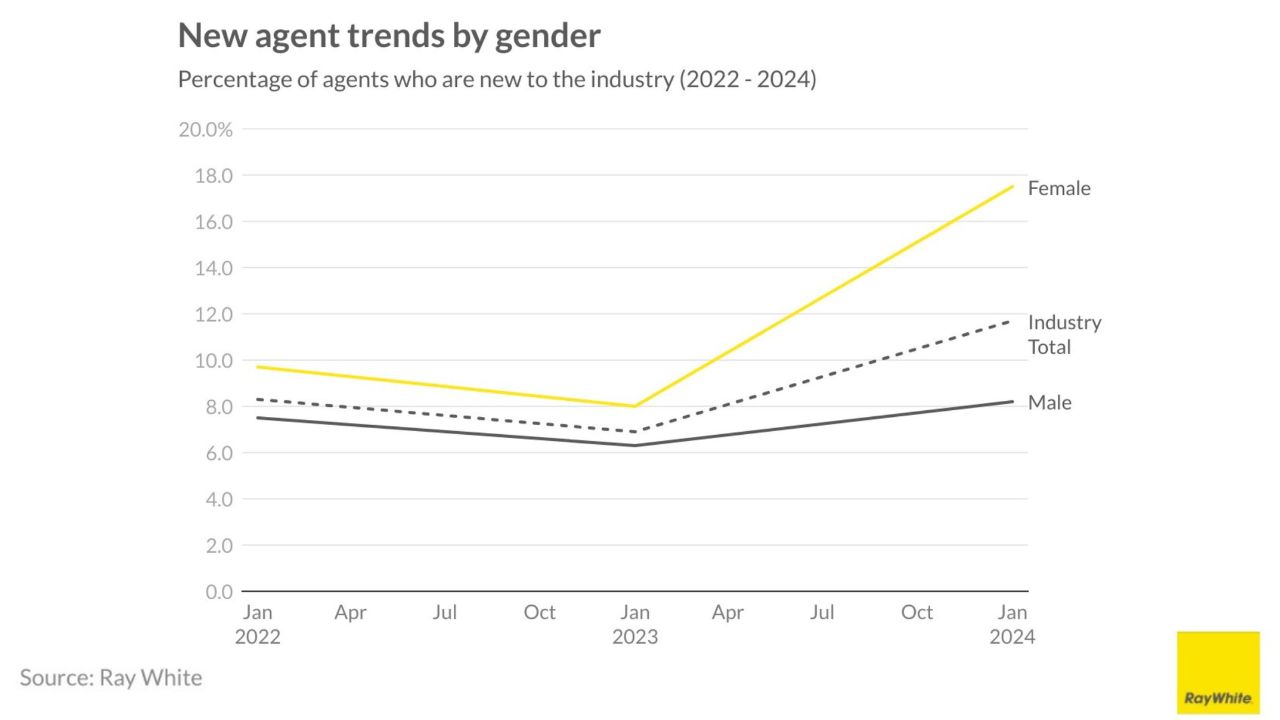A new report from Ray White has revealed a marked increase in the number of female part-time real estate agents across Australasia, with data showing women now make up a growing share of agents completing four or fewer transactions a year.
According to the research, 52.1 per cent of female sales agents fall into this category, compared to 43.3 per cent of male agents, an 8.8 percentage point gap that persists across most states and territories.
Ray White Strategy Analyst Jordan Tormey, who led the analysis, said the data was prompted by a noticeable surge in female entrants to the industry this year.
“We observed that female representation among new industry entrants more than doubled in 2024 alone.
That kind of demographic shift warranted a closer look, particularly given the growth of our Leading Ladies of Real Estate initiative, which has seen a 260 per cent increase in attendance since 2021,” Mr Tormey said.
The analysis revealed that part-time agents are not a uniform group, with two distinct segments emerging.
The first includes developmental part-timers—agents in their first year of business, while the second comprises experienced agents who deliberately choose to work fewer transactions for lifestyle or personal reasons.
Among female part-timers, 40.6 per cent were classified as developmental, compared with 27.8 per cent of male part-timers.
Conversely, 59.4 per cent of female part-timers had more than a year of experience, compared to 72.2 per cent of male part-time agents.
“These patterns highlight differing pathways into the industry. While we haven’t yet tracked long-term outcomes across these groups, the gender distribution in early-stage development is particularly striking and will be an area of further analysis,” Mr Tormey said.
The findings also show that the real estate sales sector lags behind other areas of the industry in gender balance.
While ABS data shows women make up 48 per cent of the real estate workforce overall, only 34 per cent of sales agents are female, compared with 58.9 per cent male.
By contrast, property management roles are predominantly filled by women (67 per cent), skewing the overall gender balance.
Mr Tormey said recognising the nuance in these employment patterns was crucial to understanding the wider picture of industry engagement and performance.
“Many agencies already have effective mentorship and collaborative systems. However, the significant increase in new female agents presents a timely opportunity to enhance those frameworks even further,” he said.
“By proactively responding to this shift—whether through targeted support for early-stage agents or by better accommodating lifestyle-driven professionals—agencies can boost retention, productivity, and overall engagement.”

The report also highlighted regional differences. In the Northern Territory and Victoria, women were 5.5 percentage points more likely to be part-time than men, while Tasmania showed the reverse trend, with women 2.3 points less likely to be part-time.
Western Australia, by contrast, showed near gender parity in part-time rates.
Mr Tormey said the geographic variation emphasised the importance of localised strategies over a national, one-size-fits-all approach.
With the nature of work in real estate continuing to evolve, particularly post-pandemic, the report suggests that flexibility, mentorship and a deeper understanding of agent motivations will be key to attracting and retaining talent in the years ahead.
“Real estate continues to attract people seeking entrepreneurial flexibility and meaningful earning potential. But what this data shows is that part-time work, especially among women, is not a temporary stage for everyone—it’s a deliberate choice for many,” Mr Tormey said.
“As an industry, we need to support both career-builders and those who choose a more flexible workload, because both bring value—and both represent the future of our workforce.”

